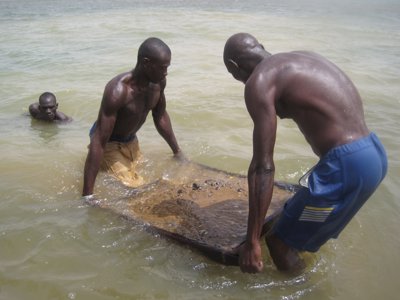Summary
North of Bamako, amid the treacherous currents of the River Niger, groups of men work beneath the hot sun to dredge sand from the river. They are gaunt and tired; they work in hazardous conditions for small amounts of money. Sand has become an increasingly valuable commodity here. The reason? There is a building boom in Mali at the moment as Malians in Bamako replace mud houses – which simply crumble during the rainy season – with concrete housing.
Jane Labous undertook an expedition in Mali, West Africa as part of her Royal Geographical Society (with IBG) Journey of a Lifetime grant. Her journey took in the capital Bamako, before heading north to Koulikouro, then on into the desert to Djenné, an eight hour drive through the savannah.
She followed the trail of the great River Niger and its sand, from the bottom of the river through the mud villages on its banks to the brave new world of Bamako, where concrete rules and “city-slickers” reside in new concrete housing. She investigated how this urbanisation process is affecting Mali's century-old traditions, its mud architecture, its traditional skill-base, its population and their livelihoods, even its environment – as people digging sand desecrate the banks of the river. Through interviews with villagers, mud masons and traditional fishermen; sand diggers, concrete builders and Bamako city dwellers, we see the drama unfold; traditional versus modern, those seeking to keep the old ways alive, versus those chasing a new dawn of Africa.
Location
The expedition took place in Mali, West Africa. Jane began her journey in the capital Bamako, before heading out to Koulikouro, about an hour north. Then on into the desert to Djenné, an eight hour drive through the savannah. Djenné is on the southern edge of the Sahara desert – the next town along is Timbuktu.
Aims
These resources aim to provide students with the chance to investigate urbanisation and migration using resources produced during the expedition.
Research techniques
-
Photographs
-
Interviews
-
Sound recordings
-
Diary notes
Key questions
What are the causes of a rapid urbanisation in Bamako?
What are the impacts of rapid urbanisation in Bamako?
What are the impacts of the sand diggers on the River Niger?
What is the connection between sand diggers and one of the fastest growing cities in the world?
What are people’s experience of life and change in Bamako?
What are the issues for young people in Bamako?
Hear Jane's report for the BBC
About the author
Robert Lang is a Chartered Geographer (Teacher) at King Edward VI Five Ways School in Birmingham. He has been an active member of the Geographical Association (GA) since his career began and is currently a member of the Association's ICT working group and a regional subject advisor. He is also currently a SSAT Lead Practioner. He has participated in and led a variety of inset and CPD opportunities focusing on GIS. He participates regularly in local meetings for geography teachers including setting up a new GA branch and RGS-IBG teacher's network in Birmingham, and has also developed links with local universities. He has been involved in the school achieving the GA's Secondary Geography Quality Mark Centre of Excellence award.
The researcher
Jane Labous
Jane Labous is a freelance journalist, age 34, who has been writing about Africa and travel / development topics for eight years. She read English and French at Jesus College, Oxford and from there worked on a range of magazines and newspapers to get experience. Writing and making radio is a passion of hers – as is finding out people's stories and telling them in a compelling way.


